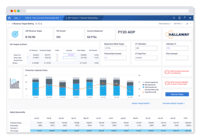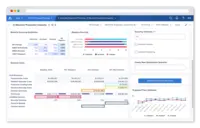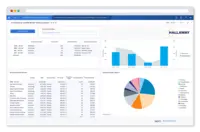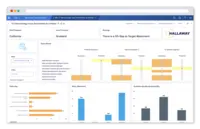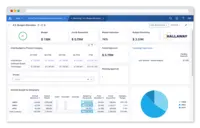Overview
What is Anaplan?
Anaplan is a transformative way to see, plan, and run your business. Using its proprietary Hyperblock™ technology, Anaplan lets you contextualize real-time performance, and forecast future outcomes for faster, confident decisions. Anaplan enables connected strategy and planning across your enterprise…
TrustRadius Insights
Anaplan: Transforming Planning Processes and Driving Business Excellence
Highly Recommended Planning and Forecasting Tool
Anaplan fan
Adapting to Client Needs with Ease
Flexible planning tool that scales with your organization
Anaplan is worth the money for any enterprise level planning
You don't need to wait until your data is clean to provide insights
Anaplan is a flexible tool that can be built for most business processes
Zero Code Cloud Native Planning & Forecasting Tool
Anaplan for Connected Planning
Anaplan Review
Anaplan, a highly flexible tool for planning
One of the most flexible modeling solution
Anaplan is the go-to for any planning process
Awards
Products that are considered exceptional by their customers based on a variety of criteria win TrustRadius awards. Learn more about the types of TrustRadius awards to make the best purchase decision. More about TrustRadius Awards
Popular Features
- Flat file integration (281)9.595%
- Forecasting (282)9.393%
- Scenario modeling (284)9.292%
- Management reporting (283)8.383%
Reviewer Pros & Cons
Pricing
What is Anaplan?
Anaplan is a transformative way to see, plan, and run your business. Using its proprietary Hyperblock™ technology, Anaplan lets you contextualize real-time performance, and forecast future outcomes for faster, confident decisions. Anaplan enables connected strategy and planning across your…
Entry-level set up fee?
- Setup fee optional
Offerings
- Free Trial
- Free/Freemium Version
- Premium Consulting/Integration Services
Would you like us to let the vendor know that you want pricing?
112 people also want pricing
Alternatives Pricing
What is Kepion Planning?
Kepion is a cloud planning & analytics software company that connects all organizations' teams under a single view of their business performance. We enable more intelligent decisions to be made by companies about their financial and operational future. Kepion global offices and partners deliver…
What is PlanGuru?
PlanGuru is budgeting, forecasting and financial analytics software for SMB's, Nonprofits and the Accountants/ Advisors that work with them.
Product Demos
Financial Consolidation demo
Anaplan Demand Planning Demo
See the Future Clearly by Planning Demand with Anaplan
Features
BI Standard Reporting
Standard reporting means pre-built or canned reports available to users without having to create them.
- 6.4Pixel Perfect reports(1) Ratings
Pixel Perfect reports are highly-formatted reports with graphics and ability to preview the report before printing.
- 9Customizable dashboards(182) Ratings
Customizable dashboards are dashboards providing the builder some degree of control over the look and feel and display options.
Ad-hoc Reporting
Ad-Hoc Reports are reports built by the user to meet highly specific requirements.
- 9.1Drill-down analysis(2) Ratings
Drill down analysis is the ability to get to a further level of detail by going deeper into the hierarchy.
- 9.1Formatting capabilities(2) Ratings
Ability to format output e.g. conditional formatting, lines, headers, footers.
- 9.1Report sharing and collaboration(2) Ratings
Report sharing and collaboration is the ability to easily share reports with others.
Report Output and Scheduling
Ability to schedule and manager report output.
- 9.1Publish to Web(1) Ratings
- 8.8Publish to PDF(188) Ratings
- 9.2Report Versioning(163) Ratings
Report versioning is the assignment of version numbers to each version of a report to help in tracking.
- 8.3Report Delivery Scheduling(3) Ratings
Report Delivery Schedule is the ability to have reports delivered to a destination at a specific data and time.
Data Discovery and Visualization
Data Discovery and Visualization is the analysis of multiple data sources in a search for patterns and outliers and the ability to represent the data visually.
- 9.1Pre-built visualization formats (heatmaps, scatter plots etc.)(2) Ratings
Pre-built visualization formats are canned visualization types that can be selected to visualize different kinds of data.
- 9.1Location Analytics / Geographic Visualization(2) Ratings
Location analytics is the visualization of geographical or spatial data.
- 6.4Predictive Analytics(2) Ratings
Predictive Analytics is the ability to build forecasting models based on existing data sets.
Access Control and Security
Access control means being able to determine who has access to which data.
- 9.1Multi-User Support (named login)(2) Ratings
Named model access means that users have access based on name and password.
- 9.5Role-Based Security Model(192) Ratings
Role-based access means that access to data is determined by job or position in the corporation.
- 9.1Multiple Access Permission Levels (Create, Read, Delete)(2) Ratings
Multiple access permission levels means that different levels of users have different rights.
- 9.4Report-Level Access Control(45) Ratings
Report-level access control means that the type of report determines who has access to it.
- 9.1Single Sign-On (SSO)(2) Ratings
Allows users to use one set of login credentials to access multiple applications
Mobile Capabilities
Support for mobile devices like smartphones and tablets.
- 8.7Responsive Design for Web Access(173) Ratings
Web design aimed at producing easy-to-read sites across a range of different devices.
- 8.2Mobile Application(162) Ratings
A dedicated app for iOS and/or Android.
- 8.3Dashboard / Report / Visualization Interactivity on Mobile(169) Ratings
In-app dashboard reports and data visualization.
Budgeting, Planning, and Forecasting
These activities are designed to assist with both data-driven operational, short-term planning and strategic long term planning
- 9.4Long-term financial planning(268) Ratings
3-5 year financial plan with cashflow.
- 9.6Financial budgeting(273) Ratings
Annual budget for revenue and operating expenses, headcount/compensation, capital expenses, projects, etc.
- 9.3Forecasting(282) Ratings
Combining actuals and budgets, rolling forecasts, driver-based models.
- 9.2Scenario modeling(284) Ratings
Financial or operational modeling of alternate future states and planning for each.
- 8.3Management reporting(283) Ratings
Budget vs. actual or forecast, P&L’s, performance over time, between products etc.
Consolidation and Close
Consolidation of data from multiple entities with currency management, reporting and audit trails.
- 8.7Financial data consolidation(229) Ratings
Consolidating data from several entities into a single statement using US GAAP, IFRS or other standards.
- 7.2Journal entries and reports(187) Ratings
Ability to enter journal entry adjustments and produce reports showing all journal entries for a specific period.
- 6.2Multi-currency management(11) Ratings
Ability to handle foreign currency conversions during consolidation.
- 6Intercompany Eliminations(8) Ratings
Matching and elimination of intercompany revenue, expenses, and balance sheet accounts.
- 6Minority Ownership(7) Ratings
Consolidate financials full or partial ownership of subsidiaries, equity pick-up.
- 8.5Local and consolidated reporting(216) Ratings
Ability to report against individual business entities and the consolidated umbrella entity.
- 8.2Detailed Audit Trails(229) Ratings
Tracing changes to data and processes that were run.
Financial Reporting and Compliance
Financial statements and regulatory filings
- 8.8Financial Statement Reporting(245) Ratings
Creation and production of balance sheets, income statements, cash flows, other schedules
- 8.4Management Reporting(257) Ratings
Tools facilitating creation of internal ad hoc or standard reports.
- 8.1Excel-based Reporting(236) Ratings
Ad hoc or formatted reports using MS Excel.
- 9Automated board and financial reporting(13) Ratings
Tools to help automate creation of regulatory reports such as SEC filings and board books.
Analytics and Reporting
Dashboards and scorecards for KPI monitoring and benchmarking
- 8.6Personalized dashboards(280) Ratings
Create custom dashboards and reports without the help of IT or administrators.
- 8.8Color-coded scorecards(264) Ratings
Track and analyze performances with interactive, color-coded balanced scorecards.
- 9.1KPIs(19) Ratings
Select from a library of more than 6,000 key performance indicators, and incorporate KPIs into your planning process.
- 9.2Cost and profitability analysis(242) Ratings
Cost and profitability analysis provides data for business decision making.
- 9.4Key Performance Indicator setting(253) Ratings
Ability to set key performance indicators for measuring progress towards goals.
- 9.1Benchmarking with external data(13) Ratings
CPI, daily exchange rates, industry KPIs. with scheduled data refreshes.
Integration
Ability to integrate with external applications.
- 9.5Flat file integration(281) Ratings
Integration of flat files like text documents and comma separated files
- 8.4Excel data integration(263) Ratings
Ability to integrate directly with Excel data.
- 8.6Direct links to 3rd-party data sources(242) Ratings
Integration with external applications like ERP, CRM, HCM
Product Details
- About
- Integrations
- Competitors
- Tech Details
- Downloadables
- FAQs
What is Anaplan?
Anaplan Features
Budgeting, Planning, and Forecasting Features
- Supported: Long-term financial planning
- Supported: Financial budgeting
- Supported: Forecasting
- Supported: Scenario modeling
- Supported: Management reporting
Consolidation and Close Features
- Supported: Financial data consolidation
- Supported: Journal entries and reports
- Supported: Local and consolidated reporting
- Supported: Detailed Audit Trails
Financial Reporting and Compliance Features
- Supported: Financial Statement Reporting
- Supported: Management Reporting
- Supported: Excel-based Reporting
Analytics and Reporting Features
- Supported: Personalized dashboards
- Supported: Color-coded scorecards
- Supported: Cost and profitability analysis
- Supported: Key Performance Indicator setting
Integration Features
- Supported: Flat file integration
- Supported: Excel data integration
- Supported: Direct links to 3rd-party data sources
BI Standard Reporting Features
- Supported: Customizable dashboards
Report Output and Scheduling Features
- Supported: Publish to PDF
- Supported: Report Versioning
Access Control and Security Features
- Supported: Role-Based Security Model
- Supported: Report-Level Access Control
Mobile Capabilities Features
- Supported: Responsive Design for Web Access
- Supported: Mobile Application
- Supported: Dashboard / Report / Visualization Interactivity on Mobile
Anaplan Screenshots
Anaplan Videos
Anaplan Competitors
Anaplan Technical Details
| Deployment Types | Software as a Service (SaaS), Cloud, or Web-Based |
|---|---|
| Operating Systems | Unspecified |
| Mobile Application | Apple iOS, Android, Mobile Web |
| Supported Countries | All countries |
| Supported Languages | Multi-lingual support |
Anaplan Downloadables
- The Anaplan Platform Explained
- Anaplan for Sales: Predictive Sales Planning
- Anaplan for Finance: Planning, Budgeting & Forecasting
- Anaplan for Supply Chain: Supply Planning
- Anaplan for HR and Workforce: Agile Workforce Planning
- Anaplan for HR and Workforce: Workforce Planning
- CHRO strategies: Delivering what the CEO wants
Frequently Asked Questions
Anaplan Customer Size Distribution
| Consumers | 0% |
|---|---|
| Small Businesses (1-50 employees) | 0% |
| Mid-Size Companies (51-500 employees) | 10% |
| Enterprises (more than 500 employees) | 90% |
Comparisons
Compare with
Reviews and Ratings
(479)Community Insights
- Business Problems Solved
- Pros
- Cons
Anaplan has been implemented in various industries to address a wide range of business challenges. Users have found that the software replaces duplicate spreadsheets and simplifies reporting processes, resulting in one version of the truth. Anaplan's inbuilt version control and access controls have improved forecasting accuracy and simplified forecasting processes. It has also helped standardize forecasting and reporting approaches across different asset classes, benefitting functions such as HR, Finance, Accounting, and Management Controlling.
The flexibility of Anaplan allows users to customize the software to meet their specific business needs. It supports a multitude of use cases including financial planning and analysis, customer success, collections, capex forecasting, opex forecasting, headcount and personal spend forecasting, balance sheet forecasting, cash flow forecasting, P&L forecasting, collections forecasting, and management reporting. Multiple users can input forecast assumptions in real-time, enabling dynamic results. Furthermore, Anaplan allows for faster implementations by providing a single platform and source of truth for multiple planning use cases.
Anaplan's powerful calculation engine enables users to run multiple scenarios in seconds, facilitating what-if analysis and scenario comparison during budgeting and forecasting processes. The software is widely used in sales performance management for functions like territory management, account planning, quota allocation, and incentive compensation planning. In addition to its extensive use cases in finance and sales planning, Anaplan is employed across various industries including real estate development, insurance, telecommunication infrastructure, and banking. The platform empowers organizations by providing scenario planning and sensitivity analysis capabilities that enable informed decision-making. With its user-friendly interface and real-time calculations, Anaplan assists businesses in centralizing data and maintaining a golden source of truth for better planning outcomes.
Highly scalable and flexible data integration and modeling capabilities: Reviewers have praised the Anaplan platform for its highly scalable and flexible data integration and modeling capabilities, allowing for easy evolution from simple calculations to complex formulas. Many users have highlighted this as a major strength of the platform.
Real-time data capabilities enabling informed decision-making: The real-time data capabilities of Anaplan have been widely praised by reviewers for enabling informed decision-making based on up-to-date information. Several users have mentioned that this feature has greatly contributed to their ability to make agile decisions in a fast-paced business environment.
User-friendly interface contributing to high end user adoption: The user-friendly interface of Anaplan has been consistently highlighted by reviewers as a key strength of the platform. Users appreciate the intuitive design, which resembles Excel and allows for quick task completion. This ease of use has contributed to high end user adoption and overall positive feedback from customers.
Limited storage: Some users have found the limited storage in Anaplan to be a hindrance in efficiently managing their data. They have expressed difficulties in storing and organizing large amounts of information, which can impact their ability to effectively utilize the software.
Expensive: Several reviewers feel that Anaplan is expensive and could be more cost-effective considering its features and capabilities. This pricing structure may make it less accessible for smaller businesses or organizations with budget constraints.
Glitches with the interface: Users report experiencing glitches with the interface, causing difficulties in navigating and performing tasks smoothly. These issues can disrupt workflow and decrease efficiency for users.
Attribute Ratings
- 9.4Likelihood to Renew25 ratings
- 8.7Availability6 ratings
- 9Performance6 ratings
- 8Usability16 ratings
- 7.7Support Rating18 ratings
- 9Online Training4 ratings
- 8.4In-Person Training4 ratings
- 8.5Implementation Rating21 ratings
- 9Configurability4 ratings
- 9.3Product Scalability6 ratings
- 9.1Ease of integration2 ratings
- 4.7Vendor pre-sale3 ratings
- 7.3Vendor post-sale3 ratings
Reviews
(101-125 of 303)I am a model builder from within our organization and have worked on implementing Incentive Compensation, Revenue Planning, Sales Booking Planning, and other models over the last 5 years. I work actively within Anaplan for about 50% of my time and work with both admins and end-users (an admin can be an end-user). We are continuing to grow our use of Anaplan and connected planning as we get more models online and more users within Anaplan. Information sharing is improved with connected planning and we are looking to see where else in our organization we can leverage Anaplan's product offering both for analysis and reporting.
- Real-time Calculation
- Error avoidance
- Business Planning
- User Experience
- Workflow
- Dashboard Design
Not Well suited: Ad-hoc reporting.
Boost your business growth with Anaplan
- Flexibility to use
- Easy to understand UI
- Comparatively easy to implement against most other on-premise EPM solutions as it doesn't require complex calculation scripts and formulae structures
- Application lifecycle management in the NUX requires tedious maintenance
- Formatting options available in the NUX are minimum and could be increased
- Storage options for Image library could also be provided
- Multi Use Case Planning
- Real TIme Collaboration
- Scenario Planning
- Predictive and Prescriptive Analysis
- Sparsity Management
- User Experience to eliminate BI
- Operational level planning
Still the Best in Cloud Planning & Analysis
- Fast and easy-to-use standard functions
- Good master data structures and management
- Efficient and easy to use new UX
- Easy tolerant and configure for IR personnel
- More flexible integration from other source systems
- Easy to connect to other systems
- ETL functionality when integrating data from other sources
- More filters on any sections when configuring lists, module, views, etc. ( Sometimes there are filters, sometimes not, finding names are very hard when there are no filters)
- Data Sparsity, handling multiple lists and creating concatenations beaches of size issues
- Syncing is not there yet, when copying a model you need to manually sync the new UX (ALM in UX)
- Scalability
- The relative ease of access for those coming from another EPM tool
- Easy to get up and running once the workspace is partitioned
- Major improvements in UX elements have made for much-improved business planning applications
- Data integrations are tedious to set up and adjust as everything should be coming through a "Data Hub" model. Changes in data sources or data sets can require an entire re-working of Data Hub model components
- Functions are rigid, with no ability to create a custom function
- BI/Reporting capabilities have come a long way, but if Anaplan sales reps are going to say it's a BI tool, then it needs to have the capabilities to compete with the real BI tools
Connecting our planning across the globe!
- Custom formulas and calculations
- Dashboarding
- Data Integration
- Multi dimensional modeling
- Transactional data processing
Quick to Market & Efficiently Scalable
- Security within the system is easily managed using roles. However, administrators can tighten security down to the individual node or apply dynamic access using logic built directly into the model.
- Common integration platforms engage with Anaplan using either APIs or other methods. This allows for talent to be shared across functions that may not specifically be focused on Anaplan development.
- Migration from development & QA to production is fairly easy and managed within the system. Centralizing this within the function allows for quick deployments and agility in hotfixes. There is also the ability to roll back a change as needed.
- Copying & archiving models is a fairly quick exercise and gives the functions the ability to save off data without specific skillsets. The data management is smooth & makes modeling very flexible.
- End users could use more notifications/explanations on what process is currently running. With 50+ concurrent users, the model can be requested to run multiple actions. This can cause one user to wait on another without fully understanding what is happening on the backend.
- The model-building experience has improved significantly in the past few years. However, there is still much room for improvement like formatting & error handling. The builder should be able to know when a formula is invalid & unable to submit. This will prevent model lockup fairly quickly.
- There could be more formalized training on best practices. Today, most companies are reliant on consulting firms to provide expertise (for the most part), and this creates a knowledge pool that is not easily accessible to all clients. Administrators internally should be able to get continued training as they progress in building their models.
Anaplan - The planning tool with high success rate
- Connected Planning connecting all people, system and data at one place
- Highly secured and Selective access plays a big role
- Automated AI/ML forecasting - PlanIQ
- New User Experience
- Data Integration
- Optimization
- Reporting in terms of visuals - Adding more charts, Improving the UI capabilities
- Selectively archive the versions and not the entire model
- Automated email to be sent - Workflow Management
- Model data copy from version to version with respect to time
Anaplan for Finance
- Dynamic planning
- Auditability
- Scenario modelling
- Replication of Excel functions
- UX reporting and graph functionality
- Multiple users in model at once
- Model performance using functions such as rank
- Model support
- Excel and Google Sheet Add Ons
Flexibility & Power Meet Ease of Use
- Flexibility in its capabilities
- Powerful yet easy to stand up
- Product support & updates
- Scalability
- More visible product roadmap
Anaplan is the tool for FP&A Transformation
- Calculation: In real time
- Security: Highly customizable down to the cell level of input.
- Flexibility: Very configurable to the requirements of any given use case. Not a list of canned options.
- History log Mining: Data exists but not always in a highly usage fashion.
- Formula auto-complete functionality similar to Excel.
- Native model to model integration has improved but I would like to see more options for workflow.
The people who work for this company are fantastic to work with and extremely helpful and genuine.
- Reports can be made simple and easy for users to review
- Task Lists in Planning are a great way to streamline a set of flows work that would otherwise be difficult for our users. They are not the most expert in the use of the software
Anaplan - Time to Automate!
In additional to connected planning and scenario analysis, it almost fully automate companies accounting process. It is able to connect to the upstream data source via ETL tools, perform multi-dimensional calculation without the worries of excel crushing, and send the result back to the same or downstream data source. There are so many cases that Anaplan saved hundreds of professional hours each month.
- connected planning
- multi-dimensional modeling
- easy to learn
- full UX experience
- expand more features
Predictive Account Scoring and Insights
- Scoring accounts with propensity to buy
- Segments different lines of business
- Provides contacts that are linked to Salesforce, can also see where you need to add more contacts
- Difficult to understand what the scoring means
- Lots of columns and rows to read, could use a better UX/UI
- Would be nice to be able to populate contacts from ZoomInfo into SFDC through Mintigo
- Predictive intent signals
- Integration with complex databases
- Integration with CRM for creating marketing campaigns
- Excellent insights for marketing folks for segmentation based analysis
- Building models
- UI/UX could be more intuitive
- Pricing could be based on usage esp if average usage is low or is restricted to a smaller team
- Issues with integration with Marketo ended up with us letting go of Marketo
- Reporting functionality could be developed
- Training on some of the internal workings of the predictive engine could help us model the data better so that better output is achieved
Anaplan review
- Supporting planning processes
- Connecting different planning processes
- Real-time calculation
- Data sparsity management
- Notifications management
- Cells attachments/comments management
Anaplan - Go for it if you Struggle with Spreadsheets
- Forecasting
- Modelling
- Processing
- Logic Development
- Listen to Customer Feedback
- Platform enhancements
- Training Material
- Managing of sparsity (but a lot of this can be solved by build methodology / expertise)
- Flexibility around titling (i.e. disconnect line items to front end management reporting titles)
Scalable solution but requires time to implement / train users
- Industry and use case agnostic.
- Powerful engine.
- User friendly audit trail and history.
- Focus on expertise in use cases outside FP&A and Supply Chain.
- Management reporting.
- Workflow.
Anaplan Provides Great Flexibility and Customization!
- Flexibility - the tool can be built the suite the company's needs. It allows for maximum customization for even the most complex business models.
- Data Integrations - the tool has the ability to connect to many different data sources so that data can be passed seamlessly.
- Connected Planning - the tool allows for teams across the organization to pass information and data back and forth between models, enhancing the ability to do connected planning
- Anaplan struggles with hierarchies where children list items have multiple parents. In our organization, we like to slice and dice the data many different ways as the solutions we sell don't fit just 1 single product hierarchy. You cannot assign more than 1 parent to a list item, which means you have to create duplicate list items and map them together in order to achieve your desired goal of looking at the single piece of data in different hierarchies.
- Speed can sometimes we an issue. If we have too many users in the model at the same time, there can be some lag in saving data inputs. Also, structural changes, such as updating a formula, can sometimes take several minutes to save if there are other processes running within the model at the same time. This makes it difficult to have more than 1 model builder making structural changes at the same time.
- Anaplan doesn't do a good job of conditional formatting. I find the functionality very limited and hard to use in a way that pleases our end users. The color options are less than ideal as well.
Used Anaplan since 2014 and implemented Anaplan since 2017
- Transparency. Anaplan allows end-users to drill into individual cells to see the underlying assumptions and/or calculations. End users can also see inputs provided by other end users.
- Security. Anaplan allows administrators to set up selective access and/or dynamic cell access to control what end users are able to read and/or write throughout the model.
- Connected Planning. Anaplan allows hundreds, if not thousands, of users to interact with a model in real-time. Anaplan can also handle various use cases. For example, a company can create an FP&A model and a Workforce Planning model and be able to enhance communication and transparency between Finance and Human Resources.
- Sparsity. Anaplan presently has size constraints. Customers do have an option to purchase Hyper models. Overall, size constraints are a constant challenge in Anaplan. Typically to mitigate size constraints models have to be built using flat/concatenated logic which can result in overly complex models to implement and ultimately for end-users to adopt.
- Security. Anaplan has very robust security capabilities but is related to the sparsity issue, if models are built using flat/concatenated logic then it can lead to overly complex solutions to enable security.
- Perception. This is more so related to customers' understanding of Anaplan. There's a tendency to assume that Anaplan should replace everything, which is often not the case. There's also a tendency to underestimate the time and/or a number of resources required to successfully implement Anaplan.
Speed, flexibility and scalability
The product help my customers save time on coming up with the plan, meaning they can spend more time analyzing and coming up with action plans.
- Connect people
- Connect processes
- Simulations and scenarios
- User interface
- Optimization
- Statistical tools
Anaplan, the Cloud Software for You
- Financial Planning & Analysis
- Sales Performance Management
- Sales & Operations Planning
- Connected Revenue Forecasting
- Executive and Management Reporting
- Hierarchy flattening
- Connection between back-end modules and front-end apps/dashboards
- Segmented revision management
Anaplan's flexibility can adress many use cases.
- Anaplan calculations within a single model are real time.
- The platform's felxibility allows to adress many uses cases
- Anaplan's functionalities are always improving and updated.
- The volumetric and space impacts needs to be weighed in before choosing an option for every new development
- Model to model communications are not real time.
- Imports from outside systems into Anaplan can be improved
Powerful EPM Tool!
- Powerful engine
- Ease of development and implementing subsequent changes
- Few customizations needed in New User Experience are missing
- The automated mail notification feature is missing
- One cannot build BI reports without increasing the model size
Great tool for building business applications
- Planning, budgeting & forecasting.
- Cost allocation.
- Data cleansing.
- Ad-hoc analysis of large data sets.
- Native data integration capabilities could be improved (and are being improved with Cloud Works).
- Slice and dice reporting is possible but can be a bit constrained compared to other OLAP tools, particularly if multiple large hierarchies are used at once. There are good reasons for this (it is an inherent part of why it is very good at performing other tasks), but should be considered if Anaplan is to take over all analytical capabilities for an organisation.




